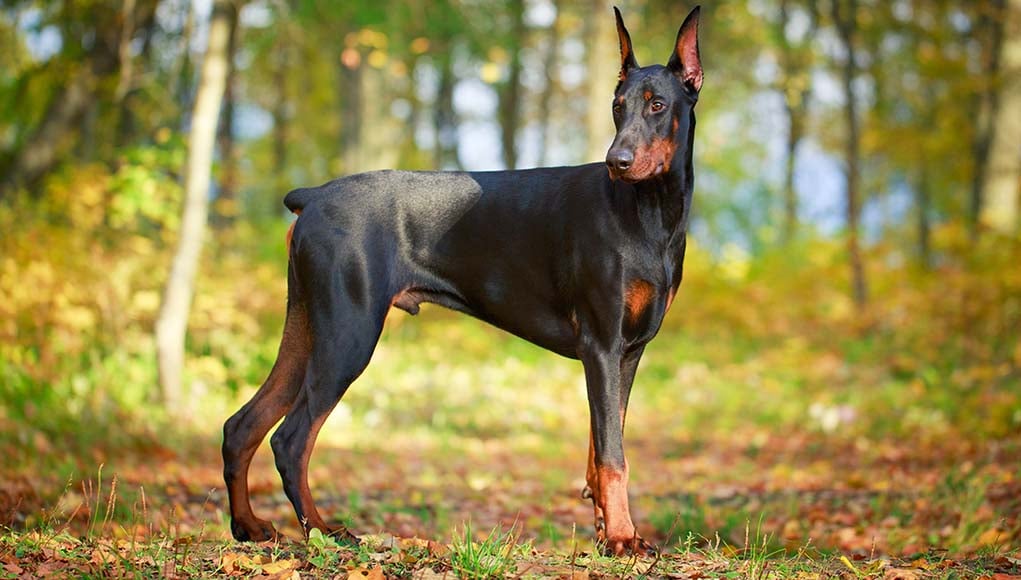Table of Contents
- Getting to Know the Doberman Pinscher
- Doberman Pinscher History & Breed Standard
- Fun Facts about the Doberman Pinscher
- Main Characteristics of a Doberman Pinscher
- The Doberman Pinscher Personality and Temperament
- Doberman General Health and Common Illnesses
- How to Take Care of your Doberman Pinschers
- Commonly Asked Questions About Doberman Pinschers
- Is a Doberman Pinscher Right For You?
What's your first impression of a Doberman Pinscher?
Most people see this dog breed as brutal, aggressive, and athletic. Even feared, they would go out of the way whenever they come across a Doberman Pinscher.
In this article, you will learn all there is to know about the Doberman Pinscher. You'd be surprised that they are not exactly what people say about them!
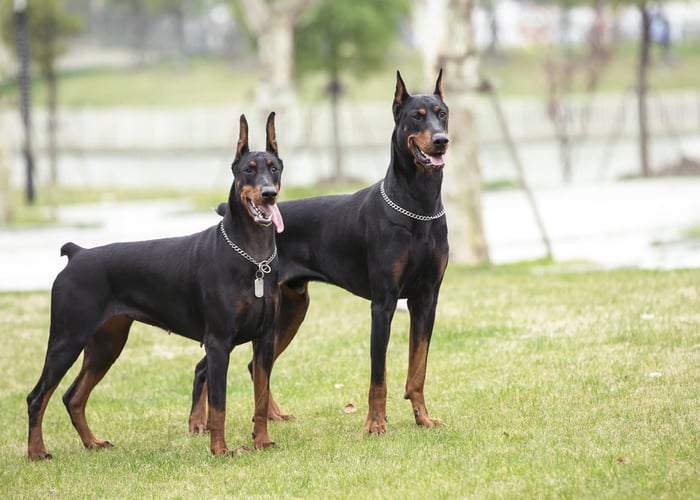
Doberman Pinschers are often stereotyped as vicious and dangerous dogs. There is some truth to this since Dobermans can be extra protective and fearless.
They are also gentle, loyal, and loving dogs, especially to their owners. The Doberman Pinschers is a family dog that thrives better around the company of family members.
One of the reasons they become so aggressive is because they are genetically predetermined and trained to protect. Any attack may be an act of self-defense to perceived threats.
Getting to Know the Doberman Pinscher
Frequently, the Doberman is affectionately called Dobie. In some countries, it's spelled as Dobermann, while other places took out the ‘Pinscher' word in its name.
Back then, Germans created this breed to be aggressive. With the modification over the years, they are the best choice when looking for both family and guard dog in one!
Known to be intelligent dogs, Doberman Pinschers can be easily trained. They also require activities that would mentally challenge them.
Since they are highly active, you might need to take them out for exercise more often. They have this particular love for action and wouldn't tolerate just sitting on the sidelines.
Dobies also have a high sense of smell and hearing. Partnered with their muscular physique and intellect, they'd make excellent police dogs.
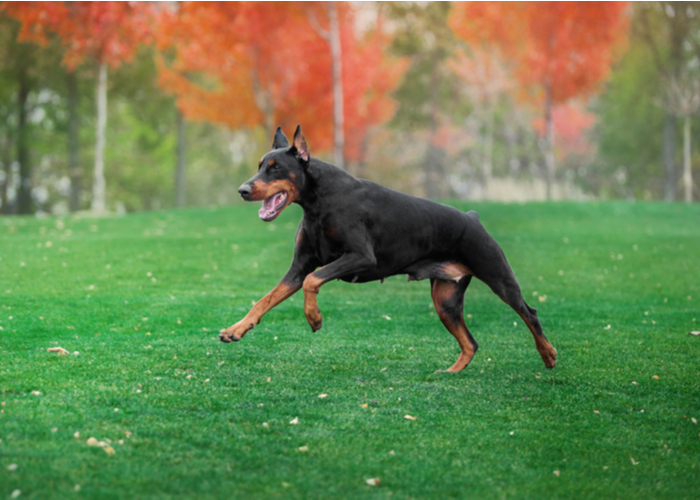
Doberman Pinscher History & Breed Standard
It was in the late 19th century that a tax collector decided to start breeding a Doberman Pinscher. This tax collector's name was Louis Dobermann.
He lived in Apolda, a town belonging to the Thuringia district of Germany, and the place was full of bandits. Louis was always worried someone would attack him every time he made his rounds.
This inspired him to start his breeding experiments of the very first Doberman Pinscher. He aimed to create a breed that is both loyal and protective.
There are no records of the dogs bred to create the Doberman Pinscher. However, they said that they are a mix of a German Pinscher, Rottweiler, and Black and Tan Terrier.
The first Dobermann was seen in 1876, and everyone showed a particular fondness for the new breed, especially for its primary function to protect.
When Louis Dobermann died, so did the knowledge of creating the Dobie. Still, the breed was named after him in his honor.
By the end of the 19th century, several German breeders tried to continue Dobermann's work. The goal was to recreate the breed for its function, and they didn't mind much about the appearance.
These breeders wanted to develop, as they called it, a “super dog.” Hence, they began breeding the most challenging, most intelligent, fastest dogs there are!
They succeeded, and the Doberman was popularly known as an aggressive dog breed. On the other hand, a breeder wanted the Doberman to be more helpful rather than just hostile.
The breeder's name is Otto Goeller, and he was credited for creating a tough yet trainable Doberman Pinscher breed.
Doberman Pinscher Breed Standard
The German Kennel Club later recognized the Doberman Pinscher as a breed in 1900. The breed standard originated in Germany and was written in German.
The Dobie was brought to America and recognized as a breed by the American Kennel Club in 1908. It even ranked 17th of the AKC Breed Popularity Ranking.
In 1921, the Doberman Pinscher Club of America was formed. After a year, they adopted the breed standard from its original German version.
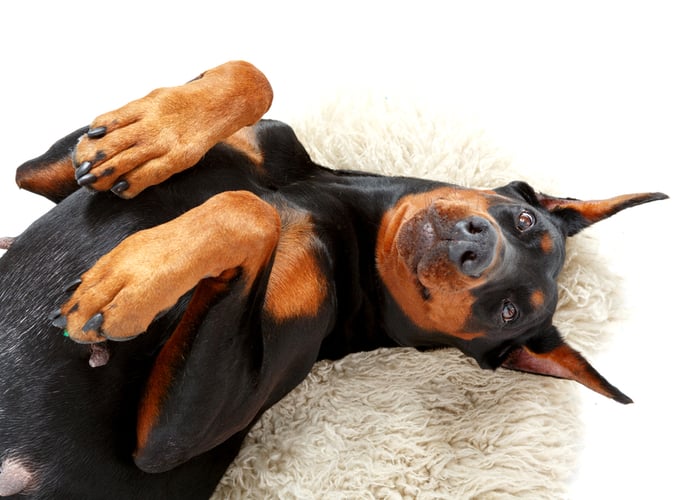
Fun Facts about the Doberman Pinscher
Ever wondered what Dobermans were like back in the days? They weren't a flourishing breed as they are right now.
They were even close to extinction during the war years. Luckily, it didn't come to that point since a few people still tried to continue breeding despite the hard times.
Here are fun facts about the Doberman Pinscher that you probably didn't know about:
- The breed would have been extinct if Americans didn't bring so many Dobermans to the United States
- The number of Dobies in Europe declined as the World War broke out. Families can no longer support large dogs to feed.
- During World War I, breeding was a luxury. So, Dobermans who survived were usually owned either by the rich, military, or police.
- The Doberman Pinscher breed was not bred by a canine breeder but by a German tax collector!
- The Germans took out the word “Pinscher” from its name in the mid-1900s. Not long after, the British did the same thing.
- A Doberman's ears used to be cropped to locate sounds better. Their tails were docked for a smoother, straighter look, but some countries considered these practices illegal.
- This breed won the “Best in Show” for three shows straight before the judges even dared to open the Dobie's mouth to check their teeth.
- This breed had its movie in the 1970s for its vicious and intelligent attributes. Even films and animations nowadays have Dobermans as the bad guys or antagonists.
- The Doberman Pinscher is a large dog breed belonging to the working group.
Dobermans always have the reputation of being hard to handle. Given the facts above, dog owners today are lucky that raising one isn't as challenging as before.
Main Characteristics of a Doberman Pinscher
Do you have a Doberman Pinscher at home? Or do you happen just to have gotten one? Perhaps you're just planning to get a pup?
Whichever is your situation, it has prompted you to this article. And you have come to the right place!
In this section, you will learn about the main characteristics that this energetic pooch has and see how it will fit into your personality and lifestyle.
Appearance
Their intimidating regal look and sleek, muscular bodies earned them a high rank in the list of scariest dogs. This is not surprising at all.
Since the Doberman was bred to protect, they had to look tough too! While some breeders didn't mind its appearance, its hostile temperament also contributed to its “scary factor.”
The Doberman Pinscher is known for its athletic build and long head. Their naturally floppy ears are often cropped to stand erect for better hearing.
Their tail is docked short. They have smooth, shiny hair, either dark red, fawn, or black, with rust markings on their face, bottom, and body.
Size of a Doberman Pinscher
Dobermans are known for their powerful stance and physique. Their standing height from the ground to their shoulder is 26 to 28 inches for males and 24 to 26 inches for females.
Male Dobies weigh more than female ones, where the male would weigh from 75 to 100 pounds while female Dobies weigh around 60 to 90 pounds.
Lifespan
The breed is generally healthy, and they can live up to 10-12 years. However, there are some health illnesses that this breed is prone to.
One digestive condition that may be common yet somehow fatal to Dobies is bloating. As dog owners, you should always be on the lookout for its symptoms.
It pays to be extra careful with your Doberman Pinscher. Even if they are known to be solid and rigid, they also need some TLC (tender loving care)!
Coat Types & Markings
The Doberman Pinscher has a short, smooth coat that is quite close to its skin. Because of this, dog owners love how minimal grooming is needed.
There are five colors listed in the breed standard for Doberman Pinschers. They are as follow:
- Black & Rust
- Blue & Rust
- Red & Rust
- Fawn (Isabella) & Rust
- White
There is no listed marking for this breed. But you will see rust markings on the throat, muzzle, chest, feet, legs, and above the eyes.
Despite the short coat length, Dobies are shedders. You should be expecting hair to fall from time to time. They don't smell bad easily. Thus, lesser baths for this breed.
Because of their very short coat, they don't tolerate cold climates well. While some dog owners put their Dobies on a sweater, a good spot in the firewood place or cuddling with a blanket is enough.
The Doberman Pinscher Personality and Temperament
A well-bred Doberman Pinscher is not primarily created to be aggressive but to be attentive enough to protect. This makes them one of the finest watchdogs a household could ever have.
With the Family
The Doberman Pinscher is a trustworthy canine companion that can be such a softie when with his family. They usually love to play with other family members.
Dobermans are family dogs and may not do so well alone or in confinement. They become happy pooches whenever being played or socialized.
Despite their authoritative nature, they are not too strong-willed or stubborn. They understand the authority of their owners, especially if they consistently show it.
They are a protector by instinct. So, it may be unavoidable for them to instantly attack anyone or anything he sees as a threat to his family.
With Children
Dobermans are very protective when it comes to children. They form a specific attachment, especially if they have been exposed to or socialized with your kids since the pup years.
Children should also be taught to be kind and to respect their dogs. Once they do, a Doberman Pinscher will return the favor.
Teach your kids to leave your Dobie alone whenever they are eating or sleeping. Avoid taking their food away, even if it's “just for fun” for the kids.
If you have younger children, it's best to supervise their interactions to avoid biting or tail-tugging that could upset your dog.
As dog owners and parents, never leave your dog and child alone unsupervised, no matter how trained or friendly the dog may be.
Doberman Pinscher With Other Dogs
Dog owners have various experiences when it comes to the interaction of their Doberman Pinschers with other dogs.
Dobermans get along with other dogs if they have been raised with them or have enough socialization. They also don't mind pups that don't appear as threats.
However, if you introduce a new dog to an adult Doberman Pinscher, both parties could take some time to adapt. Your Dobie could be unwelcoming to the new member.
Facilitate their interactions and make sure your new dog doesn't get too close to your Doberman. Once your Dobie is familiar with your new pup, they will slowly become friends!
Some owners enroll their Dobie pups in puppy kindergarten to get them socialized with other dogs at an early age. You can always take your pup on regular walks in the dog park instead.
Openness to Strangers
They are curious and playful to strangers that they see as friends to their owners. They only become aggressive when a stranger is perceived as a threat to them or the family.
Still, it pays to be extra careful when you are around other people's Dobermans or if you are taking your pooch out on a walk.
You would never know what they see as a threat, and you might end up getting dragged as your Dobie chases a stranger or a squirrel.
Know that this breed is powerful. Aside from upper muscle strength, you need a reliable dog harness to control your Dobie, just in case he gets aggressive.
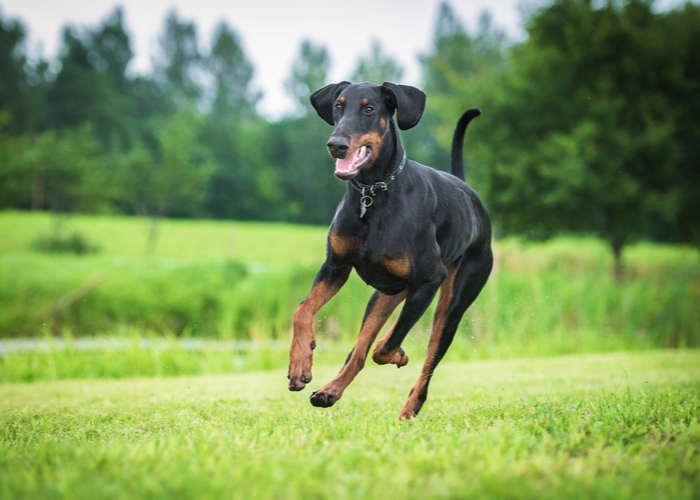
Aggression & Energy Level
The Doberman Pinscher is, no doubt, known for its reputation to be aggressive. It was the reason it was bred in the first place.
Another reason they created the breed is to protect. Their hostility may have been misinterpreted and could've been an act to protect all along.
Either way, Dobermans are intelligent, athletic, highly trainable dogs that are adaptable to the environment they're in.
They need a lot of exercises and mental stimulation to keep them occupied. Otherwise, they might start to feel frustrated or would get aggressive instead.
Doberman Pinschers would go great with older kids or active young adults since they are eager and ready to go for any physical activity or adventure.
ALSO READ: TOP #69: How to Handle Aggressive Dogs
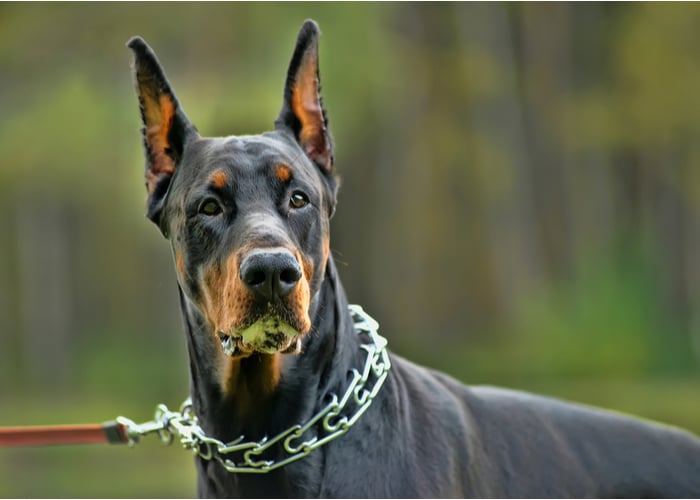
Intellect of Doberman Pinschers
The Doberman Pinscher is considered one of the most intelligent dog breeds. That's probably why they go hand-in-hand with military and police work.
At home, you ought never to run out of ideas whenever trying to train your canine because Dobies learn fast!
Still, Dobermans don't reach a level of maturity until they are three or four years old. They remain puppy-like during the first few years of their life.
Doberman General Health and Common Illnesses
The Doberman Pinscher is a healthy dog breed that is less likely to fall ill. However, there are diseases that this breed is genetically prone to.
Here are a few illnesses you should look out for:
Gastric Dilatation Volvulus (GDV)
This is commonly known as bloating. This is fatal to dogs since unreleased air could impede the blood flow towards the heart.
This usually happens to large dogs with a deep chest, such as the Doberman Pinscher. GDV occurs after eating a large meal fast or exercising after a meal.
When the blood flow is blocked, your dog will go into shock. The longer it takes to treat GDV, the more likely your dog could die from it.
Common symptoms of GDV are a swollen stomach, excessively salivating, rapid heart rate, and retching without any vomit. If these symptoms show, take your dog to the vet immediately.
Hip Dysplasia
This is a genetic condition wherein the thighbone doesn't properly fit into the hip joint. A clear symptom is the lameness of one or both rear legs.
Other symptoms would be pain or discomfort. But some Doberman Pinschers don't show any pain and are quite okay with their displacement.
Dobermans with hip dysplasia will suffer from arthritis as they age. Also, dogs with this illness are not advised to be bred.
Dilated Cardiomyopathy (Enlarged Heart)
It is known as a heart disease where the heart chambers expand while the walls become thin and weak, making it appear like an above-normal large heart.
Dogs with this cardiomyopathy are known to die from heart failure since the heart muscles will be too weak to pump blood to the rest of the body.
There are treatments for this condition, such as fluid therapy, medication, and oxygen.
Von Willebrand's Disease (A Clotting Disorder)
This is an inherited blood disorder that affects the dog's blood clotting ability. The typical symptom is excessive bleeding after an injury or surgery.
Doberman Pinschers with this disorder may also experience nosebleeds, bleeding gums, or bleeding in the stomach. There is no cure for this, but blood transfusion can help your dog.
They can still live everyday life. They can detect this illness at an early age. However, they are discouraged from being bred.
Progressive Retinal Atrophy (PRA)
Referring to an eye disorder, this involves the deterioration of the retina explicitly. At first, Dobermans with PRA will be night-blind.
If left untreated, the affected dog will soon lose their eyesight. Dogs can adapt to blindness as long as the surrounding are the same.
Albinism
If you think that this condition only occurs in humans, dogs can suffer from it too! Doberman Pinschers are pretty susceptible to it.
They are not just white dogs, but they can also have a pink nose, skin, and light-colored eyes. Dobies with this condition is sensitive to sunlight and prone to cancer and eye problems.
Hypothyroidism
A condition where your thyroid glands do not produce enough hormones into your body. This negatively affects your dog's health and result in hair loss, obesity, epilepsy, and skin conditions.
In other cases, it would cause your Doberman to be lethargic or sluggish. Fortunately, you can treat it with medication and diet.
Wobbler's Syndrome
This is a genetic disorder in Doberman Pinschers where spinal cord compression happens because of a malformed spinal cord or unstable cervical vertebrae.
Symptoms could range from simple neck pain to paralysis of the legs. Surgery is still debated as a treatment since the condition reoccurs even after surgery.
Narcolepsy
Just like the neurological disorder in humans, narcolepsy in dogs is shown by excessive sleepiness. There is no treatment discovered yet.
Color Mutant Alopecia
It is a skin condition evident in Dobermans that have blue, red, or fawn coat colors. The symptoms arise from the 4th month until their third year.
This disease is distinguished by patchy hair loss, where only the blue areas are affected. The more mature the dog grows, the more brittle its hair becomes.
A dog can appear normal with a healthy coat at first. There is no cure for this condition, but it can be managed with medicated shampoos for itching.
Recommended Tests for the Doberman Pinscher
Here are the health tests that you should ensure that your breeder should have before handing the Dobie pup to you. Best to have a copy of this checklist too and ask the breeder yourself.
- Hip Evaluation
- Cardiac Exam
- Von Willebrand's Disease DNA Test
- Thyroid Evaluation
- Ophthalmologist Evaluation
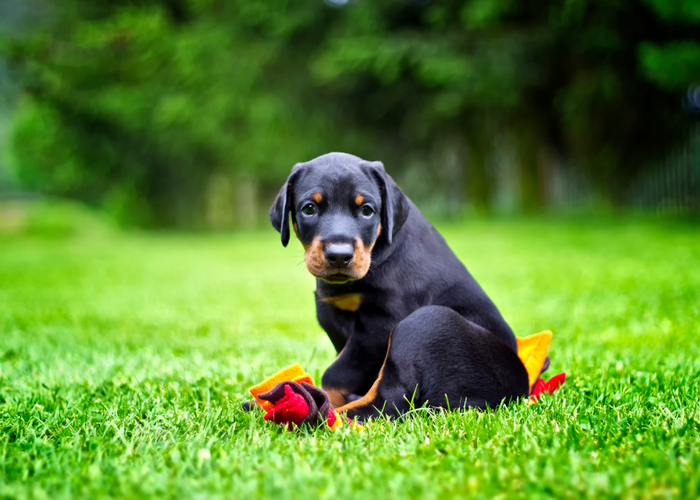
How to Take Care of your Doberman Pinschers
The Doberman Pinscher is an amazing dog breed that not even a thousand words would suffice to describe it. They are fun, smart, brave, sweet, and trustworthy.
They have the qualities you need in a family dog as well as that of a guard dog.
Since they're devoted to being our loyal companions and protectors, they deserve nothing but the best from us, dog owners, too!
Here are simple yet effective ways you take care of your Dobie
How to Groom a Doberman Pinscher
Do you know what makes most dog owners love this breed even more? Low maintenance!
The Doberman Pinscher has very short, smooth hair that can be managed with a grooming mitt or short-bristle brush. This breed does not need frequent baths.
They don't smell bad fast. You can even wipe off their hair with a paper towel that has baby oil in it. Then, they are all good to go!
Their nails need to be trimmed at least once a month. Brush their teeth regularly as well as clean your dog's ears to avoid potential problems.
Training
In an article by the National Library of Medicine, there are about 4.3 million people who get bitten by dogs every year. You don't want to add to this number!
You don't want your dog to be contributing to this population either! That's why obedience training should be the first on your list if you have a Doberman.
If your Fido is showing signs of aggression at first, it's best to ask for assistance with professional dog training. Using positive reinforcement is usually effective with them.
Training should also be fun since Dobies learn so fast that they easily get bored. This means you'll need to prepare enough lessons to keep them interested.
Make sure you are there in every step of the training. It's one way for your Dobie to build his trust in you.
During training, you also need to establish authority and lead the alpha role in the household. Otherwise, your Dobie will assume the role for you.
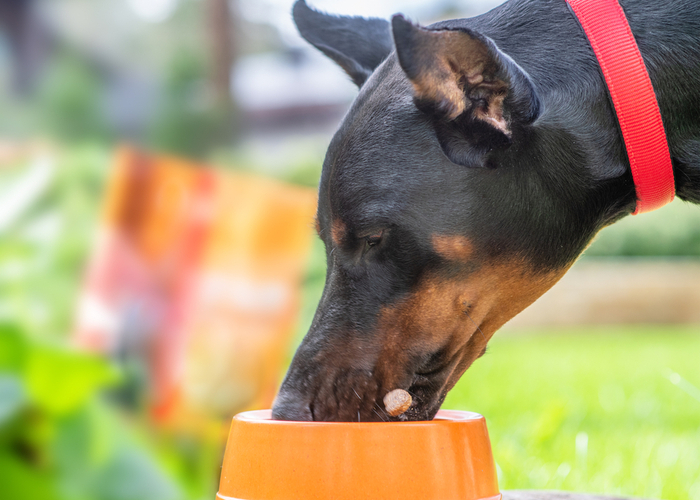
Feeding
Large dog breeds such as the Doberman Pinscher require 1800 to 2000 calories to maintain a balanced diet and weight.
Most vets recommend feeding your pup with kibbles. In this case, you might need to feed your Dobie 3 to 4.5 cups of kibbles every day.
Fortunately, there are plenty of dog food brands that offer high-quality, organic nutrition for your pooch to reach its calorie needs.
Once your dog has outgrown its puppy stage, you can always explore homemade dog food recipes for your Doberman. However, make sure to consult your vet first.
Commonly Asked Questions About Doberman Pinschers
Dog owners and soon-to-be Doberman fur parents have questions when it comes to this breed. Here are some of them:
Are Doberman pinschers good family dogs?
The Doberman makes a great family dog. They are loyal, trustworthy, and protective. However, they need to be trained and socialized properly first.
They are natural protectors, especially to the young ones in the family. You wouldn't worry much about having both this pooch and your children in one room.
When it comes to introducing a new dog to the family, your Dobie might be aggressive at first as part of their protective nature.
With enough socializing and training, your new pooch and Dobie would eventually become friends! Just make sure to supervise their interactions from time to time.
Are Dobermans aggressive?
The Doberman Pinscher's reputation precedes them. In fact, this breed was considered one of the most aggressive dog breeds.
They were commonly used as police or guard dogs and can be intimidating. They are genetically bred to protect, which is not surprising if they are hostile to strangers.
In a study by the Centers for Disease Control and Prevention, 279 deaths in America were listed from 1979 to 1994. You don't want to add to the numbers.
It's best to have your Doberman trained by a professional dog trainer before they harm you or the people around you.
What are Doberman Pinschers used for?
The Doberman Pinscher is quite a flexible breed. Aside from making a fine guard dog, they can be the best family canine companion.
They help the police as search and rescue dogs for their sharp sense of smell and hearing. Dobies also make great service dogs because of their trainability and nature to protect.
Dobermans have a gentle side that would make them good therapy dogs, though the notion may not be that popular because of their reputation.
When it comes to sports and dog shows, they would make great partners because of their strong physique, agility, and obedience.
Why are Doberman pinschers good family dogs?
If trained and socialized properly, Dobies can be very affectionate with their owners. After all, they are family dogs, and they love spending time with people.
They are loyal to their owner and are pretty with good children — may even learn to be protective of them. In some cases, a Doberman Pinscher can be attached to one person.
Doberman pinschers are considered people-oriented dogs that are affectionate and sweet if socialized and trained correctly. They are loyal to their owners and are good with children if raised with them.
What is the difference between a Doberman and a Doberman pinscher?
“Doberman” came from the word Doberman Pinscher. A few countries, including the U.S., dropped the “Pinscher” word.
Still, both two terms refer to the same breed. And there is no difference between the two names when it comes to the Doberman breeds.
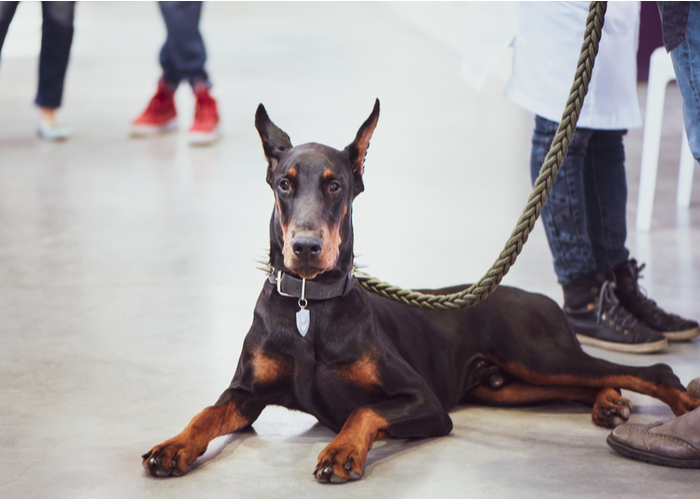
Is a Doberman Pinscher Right For You?
One thing is for sure: It's not the ideal breed for first-time dog owners. Because of their hostile temperament and the need for obedience training, having a Doberman might be overwhelming.
Still, if you are up for the challenge, you need to have an active lifestyle to have enough energy and time to train your Dobie.
You must also be prepared to deal with their aggressive behavior, especially in the first few parts of the training. Ask the help of a professional dog trainer if you must.
Once you get through all that, the Doberman Pinscher is an excellent company to keep. It would be like having your best friend and guardian in one!


